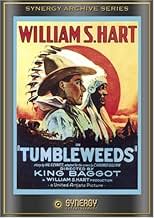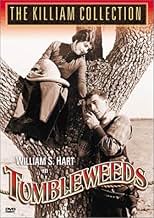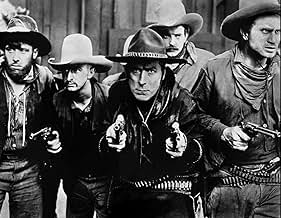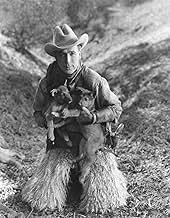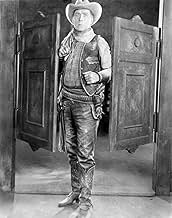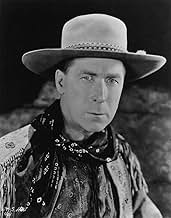Aggiungi una trama nella tua linguaThe government will grant a fringe of terrain for the settlers who want to live and work there. The starting sign will be a gunshot which will iniciate the run for the best fields and claims... Leggi tuttoThe government will grant a fringe of terrain for the settlers who want to live and work there. The starting sign will be a gunshot which will iniciate the run for the best fields and claims.The government will grant a fringe of terrain for the settlers who want to live and work there. The starting sign will be a gunshot which will iniciate the run for the best fields and claims.
- Regia
- Sceneggiatura
- Star
William S. Hart
- Don Carver
- (as Wm. S. Hart)
- …
Richard Neill
- Bill Freel
- (as Richard R. Niell)
George F. Marion
- Old Man
- (as George Marion)
Taylor N. Duncan
- Cavalry Major
- (as Ted Duncan)
Nora Cecil
- Pioneer Mother
- (non citato nei titoli originali)
Nino Cochise
- Indian
- (non citato nei titoli originali)
Monte Collins
- Hicks
- (non citato nei titoli originali)
Fred Gamble
- Hotel Proprietor
- (non citato nei titoli originali)
George Marion
- Homesteader
- (non citato nei titoli originali)
Apache Bill Russell
- Indian
- (non citato nei titoli originali)
Recensioni in evidenza
For many years prior to 1889, the US government leased the lands of the Indian Territory to cattleman for grazing their cattle herds. Ranches were built. Now the ranchers had to leave by April 1889 as 1200 square miles of the Oklahoma territory were being opened to new homesteaders. (There would be other Oklahoma land runs throughout the 1890s.)
Hart's character, Don Carver, is the typical quiet and intense cowboy known as a "tumbleweed," a drifting cowhand. Carver and his comedic sidekick Kentucky Rose (Lucien Littlefield) ride into the town of Caldwell, Kansas, population 200. This is the calm before the storm as homesteaders begin to pour into town for the big land run. Carver, and later Kentucky, decides to register for the rush, to acquire a piece of free land. The US Cavalry, in charge, has posted warnings that those who jump the starting line before the appointed time will be arrested as "sooners" and kept in a pen until after the land rush.
Seedy Bill Freel, a/k/a Burton (Richard Niell), craves Joe Hinman's Box K Ranch on the Strip (abandoned by decree) as it controls the waterways of the area. He has a devious plan to sneak across the starting line before the assigned date and time. His new partner is nefarious Noll Lassiter (J. Gordon Russell), half-brother of Molly Lassiter (Barbara Bedford). Freel has a yearning for Molly, who loathes him. She has instead developed a relationship with Carver, nearly forty years her senior in real life. Like Freel, Carver also has his eyes on the Box K property (where he formerly worked), including the ranch house.
When Don rides back into the Strip to look for and round up some straying cattle, he is arrested by US Cavalry Major White (Taylor Duncan) at the instigation of Freel and Noll Lassiter. These sordid characters have falsely accused him of being a "sooner." Now by law Carver is kept in the bull pen until after the land run. How Carver escapes is quite innovative, and he happens to have the fastest steed nearby. If only he can make up the lost ground and stake the Box K Ranch grounds.
When William S. Hart reissued this 1925 silent film (his last and perhaps greatest) in 1939, he preceded it with his famous eight- minute "Farewell to the Screen" introduction. Knowing the real West, Hart had arrived in Hollywood in 1914 at the mature age of 49 and acted for eleven years. He and Tom Mix were the greatest cowboys of the silent screen. Hart's partner here, Lucien Littlefield, specialized in playing older roles. In "Tumbleweeds" he looks about sixty even though he is only thirty. Although not as good as "The Iron Horse" (1924), the greatest silent western of them all, "Tumbleweeds" is still worth a look, especially because of the rousing land rush scene, an epic shot from the days of silent cinema.
Hart's character, Don Carver, is the typical quiet and intense cowboy known as a "tumbleweed," a drifting cowhand. Carver and his comedic sidekick Kentucky Rose (Lucien Littlefield) ride into the town of Caldwell, Kansas, population 200. This is the calm before the storm as homesteaders begin to pour into town for the big land run. Carver, and later Kentucky, decides to register for the rush, to acquire a piece of free land. The US Cavalry, in charge, has posted warnings that those who jump the starting line before the appointed time will be arrested as "sooners" and kept in a pen until after the land rush.
Seedy Bill Freel, a/k/a Burton (Richard Niell), craves Joe Hinman's Box K Ranch on the Strip (abandoned by decree) as it controls the waterways of the area. He has a devious plan to sneak across the starting line before the assigned date and time. His new partner is nefarious Noll Lassiter (J. Gordon Russell), half-brother of Molly Lassiter (Barbara Bedford). Freel has a yearning for Molly, who loathes him. She has instead developed a relationship with Carver, nearly forty years her senior in real life. Like Freel, Carver also has his eyes on the Box K property (where he formerly worked), including the ranch house.
When Don rides back into the Strip to look for and round up some straying cattle, he is arrested by US Cavalry Major White (Taylor Duncan) at the instigation of Freel and Noll Lassiter. These sordid characters have falsely accused him of being a "sooner." Now by law Carver is kept in the bull pen until after the land run. How Carver escapes is quite innovative, and he happens to have the fastest steed nearby. If only he can make up the lost ground and stake the Box K Ranch grounds.
When William S. Hart reissued this 1925 silent film (his last and perhaps greatest) in 1939, he preceded it with his famous eight- minute "Farewell to the Screen" introduction. Knowing the real West, Hart had arrived in Hollywood in 1914 at the mature age of 49 and acted for eleven years. He and Tom Mix were the greatest cowboys of the silent screen. Hart's partner here, Lucien Littlefield, specialized in playing older roles. In "Tumbleweeds" he looks about sixty even though he is only thirty. Although not as good as "The Iron Horse" (1924), the greatest silent western of them all, "Tumbleweeds" is still worth a look, especially because of the rousing land rush scene, an epic shot from the days of silent cinema.
Veteran Western film actor William S. Hart was looking for just one more chance to be in a movie. A couple (1915-1916) of the 11 years he appeared in front of the camera, theater owners voted him their biggest money-making star. His schtick was playing the prototype quiet Westerner who dressed plainly. In all of his films his characters went from mostly a bad-behaving gunslinger or ruffian to become the ultimate moralistic hero. But the public wanted flashier cowboys, such as popular Tom Mix, and more action sequences than contained in a typical character-driven Hart film.
His employer, Paramount Pictures, in 1924 elected not to renew his contract, leaving Hart unemployed at age 60. The actor wanted to ride off into the sunset for one last movie. He dug deep into his wallet and produced his final film, one that critics agree was his best one in a relatively long career, December 1925's "Tumbleweeds." Hart hired scriptwriter Hal Evarts to wrap his story around the 1893 Oklahoma land rush and King Baggot to direct.
Hart intended "Tumbleweeds" as his last hurrah with several references within the script that the Old West is gone since the Oklahoma homesteaders were replacing the cowboys he had been portraying on screen. Hart plays the foreman of a big cattle ranch. The United States government during the early 1890s had ordered all large cattle herds to leave the prairie to be replaced by the new settlers who primarily farmed. Likening himself to a tumbleweed, a plant with no roots, he witnesses other herds leaving and says, "Boys, it's the end of the West." Even women can't cox him into settling down as Hart makes the remarkable statement towards the movie's conclusion that "Women ain't reliable-cows are." Carver (Hart) says he's "headed for South America where there's millions of 'em."
Embedded within the high-budgeted $312,000 film, an immense expense in those days for one person to finance, is a specular land rush scene involving almost 1,000 extras, 300 wagons and a number of horses hired to replicate the scene. The 1931 epic "Cimarron," the Academy Awards Best Picture winner that year, copied Hart's chaotic stampede of homesteaders racing to secure the best land they could stake their claim on.
Hart was able to contract United Artists to distribute "Tumbleweeds." But the actor was disappointed, despite the rave reviews the movie was receiving, because the studio didn't place the film into the larger city venues. He sued UA for such a lack of distribution, but settled out of court in 1940. A year before that, on the heels of John Ford's 1938 "Stagecoach," which rejuvenated the Western genre, Hart was asked to provide a prologue to the re-issuance of "Tumbleweeds" with a soundtrack. The 75-year-old retired actor, now a ranch owner in Newhall, California, gave an eight-minute introduction, with his last words, "The saddle is empty, the boys up ahead are calling, they're waiting for you and me to help drive this last great round-up into eternity." Hart rode into his final sunset in June 1946 at 81 years of age at his ranch. The silent Western movie star is buried near his birthplace in Brooklyn, N. Y.'s Green-Wood Cemetery.
His employer, Paramount Pictures, in 1924 elected not to renew his contract, leaving Hart unemployed at age 60. The actor wanted to ride off into the sunset for one last movie. He dug deep into his wallet and produced his final film, one that critics agree was his best one in a relatively long career, December 1925's "Tumbleweeds." Hart hired scriptwriter Hal Evarts to wrap his story around the 1893 Oklahoma land rush and King Baggot to direct.
Hart intended "Tumbleweeds" as his last hurrah with several references within the script that the Old West is gone since the Oklahoma homesteaders were replacing the cowboys he had been portraying on screen. Hart plays the foreman of a big cattle ranch. The United States government during the early 1890s had ordered all large cattle herds to leave the prairie to be replaced by the new settlers who primarily farmed. Likening himself to a tumbleweed, a plant with no roots, he witnesses other herds leaving and says, "Boys, it's the end of the West." Even women can't cox him into settling down as Hart makes the remarkable statement towards the movie's conclusion that "Women ain't reliable-cows are." Carver (Hart) says he's "headed for South America where there's millions of 'em."
Embedded within the high-budgeted $312,000 film, an immense expense in those days for one person to finance, is a specular land rush scene involving almost 1,000 extras, 300 wagons and a number of horses hired to replicate the scene. The 1931 epic "Cimarron," the Academy Awards Best Picture winner that year, copied Hart's chaotic stampede of homesteaders racing to secure the best land they could stake their claim on.
Hart was able to contract United Artists to distribute "Tumbleweeds." But the actor was disappointed, despite the rave reviews the movie was receiving, because the studio didn't place the film into the larger city venues. He sued UA for such a lack of distribution, but settled out of court in 1940. A year before that, on the heels of John Ford's 1938 "Stagecoach," which rejuvenated the Western genre, Hart was asked to provide a prologue to the re-issuance of "Tumbleweeds" with a soundtrack. The 75-year-old retired actor, now a ranch owner in Newhall, California, gave an eight-minute introduction, with his last words, "The saddle is empty, the boys up ahead are calling, they're waiting for you and me to help drive this last great round-up into eternity." Hart rode into his final sunset in June 1946 at 81 years of age at his ranch. The silent Western movie star is buried near his birthplace in Brooklyn, N. Y.'s Green-Wood Cemetery.
"Tumbleweeds" is a classic of the silent era. It marked the final film in the career of western movie pioneer William S. Hart.
The plot revolves around the Cherokee Land Rush of 1889 Oklahoma where a large tract of land was thrown open to the public for the taking by the American government.
Don Carver (Hart) and his pal Kentucky Rose (Lucien Littlefield) had been earning their living as "tumbleweeds", another name for drifting cowpokes. When the last roundup is completed, they decide to take part in the land rush. Carver meets up with the charming Molly Lassiter (Barbara Bedford) after having had an altercation with her half brother Noll (J. Gordon Russell). Noll teams up with Bill Freel (Richard R. Neill) to acquire a choice ranch section by any means necessary. Turns out that Carver has his sights set on the same ranch which he wants to get for Molly.
The highlight of the film is of course, the land rush sequence. It is marvelously staged by Directors King Baggot and Hart himself. A cast of thousands was employed. A remarkable piece of film making for this or any other time.
The version of the film that is usually shown these days is the 1939 re-issue which had sound effects added, as well as a moving prologue filmed especially for this version. It features Hart coming out of retirement and describing the film and then talking about his career and in effect saying goodbye to all of his fans. He had left films after "Tumbleweeds" following a dispute with the film's distributor.
Hart had always insisted on realism in his films. This had worked in his early films but in the 20s, he had to compete with the more popular films of the flamboyant Tom Mix. He had reached his 60s by this time so he wisely decided to go out on top.
Ohh...the thrill of it all!
The plot revolves around the Cherokee Land Rush of 1889 Oklahoma where a large tract of land was thrown open to the public for the taking by the American government.
Don Carver (Hart) and his pal Kentucky Rose (Lucien Littlefield) had been earning their living as "tumbleweeds", another name for drifting cowpokes. When the last roundup is completed, they decide to take part in the land rush. Carver meets up with the charming Molly Lassiter (Barbara Bedford) after having had an altercation with her half brother Noll (J. Gordon Russell). Noll teams up with Bill Freel (Richard R. Neill) to acquire a choice ranch section by any means necessary. Turns out that Carver has his sights set on the same ranch which he wants to get for Molly.
The highlight of the film is of course, the land rush sequence. It is marvelously staged by Directors King Baggot and Hart himself. A cast of thousands was employed. A remarkable piece of film making for this or any other time.
The version of the film that is usually shown these days is the 1939 re-issue which had sound effects added, as well as a moving prologue filmed especially for this version. It features Hart coming out of retirement and describing the film and then talking about his career and in effect saying goodbye to all of his fans. He had left films after "Tumbleweeds" following a dispute with the film's distributor.
Hart had always insisted on realism in his films. This had worked in his early films but in the 20s, he had to compete with the more popular films of the flamboyant Tom Mix. He had reached his 60s by this time so he wisely decided to go out on top.
Ohh...the thrill of it all!
Seen in a 16mm print from the 1939 release (not necessarily the 1975 restoration listed by imdb), the sheer sincerity of the film-makers appealed highly. Intelligent art-gallery audience loved it - shown on 40th anni of Hart's death. Sound was coarse (expected) but loud and consistent in quality with image
After a while, watching "Tumbleweeds" starts to feel like homework. The movie wore me down after a while. I've seen a lot of silent movie comedies. Many of them aged quite well. As for as dramas go, I haven't seen nearly as many. For me they haven't aged as well. They are a lot harder to watch than the comedies. Add into the mix a very stiff (and seemingly self-serious) William S. Hart and "Tumbleweeds" doesn't stand a chance. There are a few laughs and some exciting action but they are too few and far between. "Tumbleweeds" is okay but it feels a lot longer than its actual running time.
Lo sapevi?
- Quiz(at around 1h 7 mins) Just after the locked-up "Sooners" rush Dan Carver, who is cutting through a rail, the scene shifts to a team of horses pulling a wagon. The right "off" wheeler horse can be seen to go lame but continue running with a noticeable limp.
- Citazioni
Don Carver: Boys - it's the last of the West.
- Versioni alternativeThe 1939-reissued version was preceded by an eight-minute sound prologue with William S. Hart introducing the film.
- ConnessioniFeatured in The Great Chase (1962)
I più visti
Accedi per valutare e creare un elenco di titoli salvati per ottenere consigli personalizzati
Dettagli
Botteghino
- Budget
- 312.000 USD (previsto)
- Tempo di esecuzione1 ora 18 minuti
- Mix di suoni
- Proporzioni
- 1.33 : 1
Contribuisci a questa pagina
Suggerisci una modifica o aggiungi i contenuti mancanti

